BMP3005 Business Management: Improving Financial Performance
VerifiedAdded on 2023/06/17
|13
|2593
|448
Report
AI Summary
This report defines financial management and its importance, discussing key financial statements like the balance sheet, income statement, and cash flow statement, alongside the use of ratios in financial management. It includes a practical application using a provided template and Excel to create an income statement and balance sheet for a sample organization. The report then analyzes the company's profitability, liquidity, and efficiency based on ratio analysis results from the case study. Finally, it describes and discusses processes this business might use to improve their financial performance, such as debt consolidation, maintaining positive income, minimizing overhead costs, seeking professional help, and liquidation of resources, concluding with the critical role of financial management in organizational success.
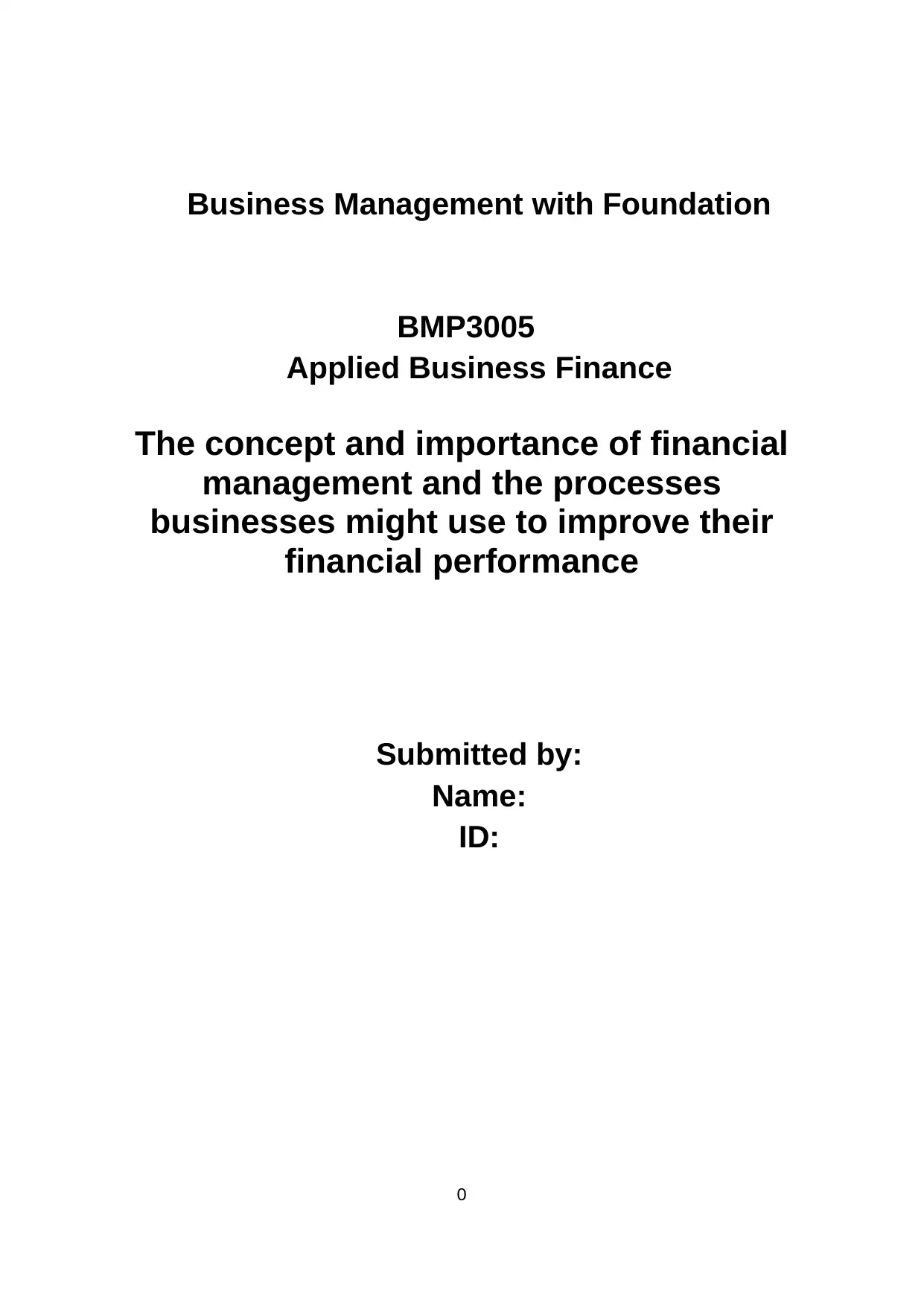
Business Management with Foundation
BMP3005
Applied Business Finance
The concept and importance of financial
management and the processes
businesses might use to improve their
financial performance
Submitted by:
Name:
ID:
0
BMP3005
Applied Business Finance
The concept and importance of financial
management and the processes
businesses might use to improve their
financial performance
Submitted by:
Name:
ID:
0
Paraphrase This Document
Need a fresh take? Get an instant paraphrase of this document with our AI Paraphraser
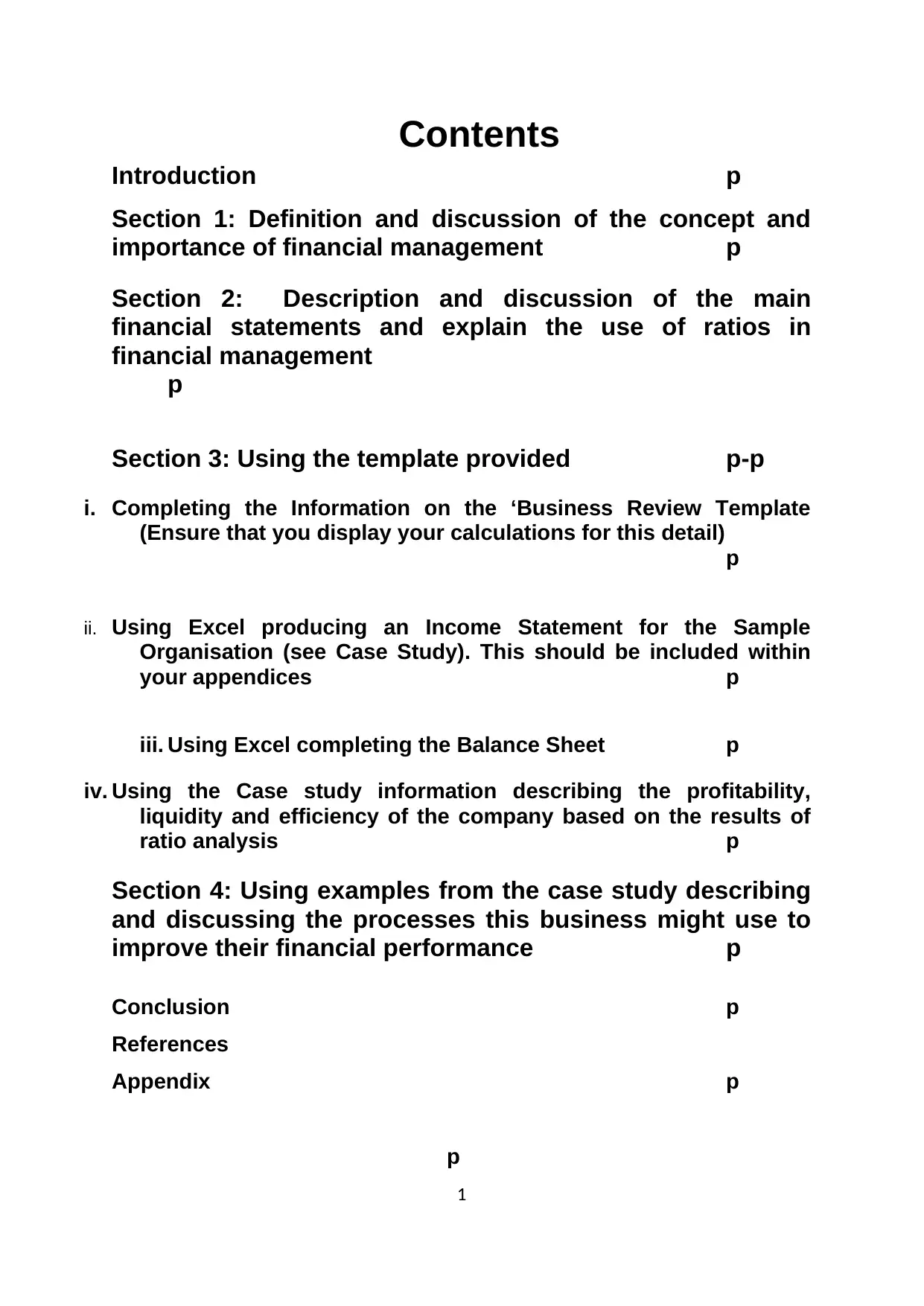
Contents
Introduction p
Section 1: Definition and discussion of the concept and
importance of financial management p
Section 2: Description and discussion of the main
financial statements and explain the use of ratios in
financial management
p
Section 3: Using the template provided p-p
i. Completing the Information on the ‘Business Review Template
(Ensure that you display your calculations for this detail)
p
ii. Using Excel producing an Income Statement for the Sample
Organisation (see Case Study). This should be included within
your appendices p
iii. Using Excel completing the Balance Sheet p
iv. Using the Case study information describing the profitability,
liquidity and efficiency of the company based on the results of
ratio analysis p
Section 4: Using examples from the case study describing
and discussing the processes this business might use to
improve their financial performance p
Conclusion p
References
Appendix p
p
1
Introduction p
Section 1: Definition and discussion of the concept and
importance of financial management p
Section 2: Description and discussion of the main
financial statements and explain the use of ratios in
financial management
p
Section 3: Using the template provided p-p
i. Completing the Information on the ‘Business Review Template
(Ensure that you display your calculations for this detail)
p
ii. Using Excel producing an Income Statement for the Sample
Organisation (see Case Study). This should be included within
your appendices p
iii. Using Excel completing the Balance Sheet p
iv. Using the Case study information describing the profitability,
liquidity and efficiency of the company based on the results of
ratio analysis p
Section 4: Using examples from the case study describing
and discussing the processes this business might use to
improve their financial performance p
Conclusion p
References
Appendix p
p
1
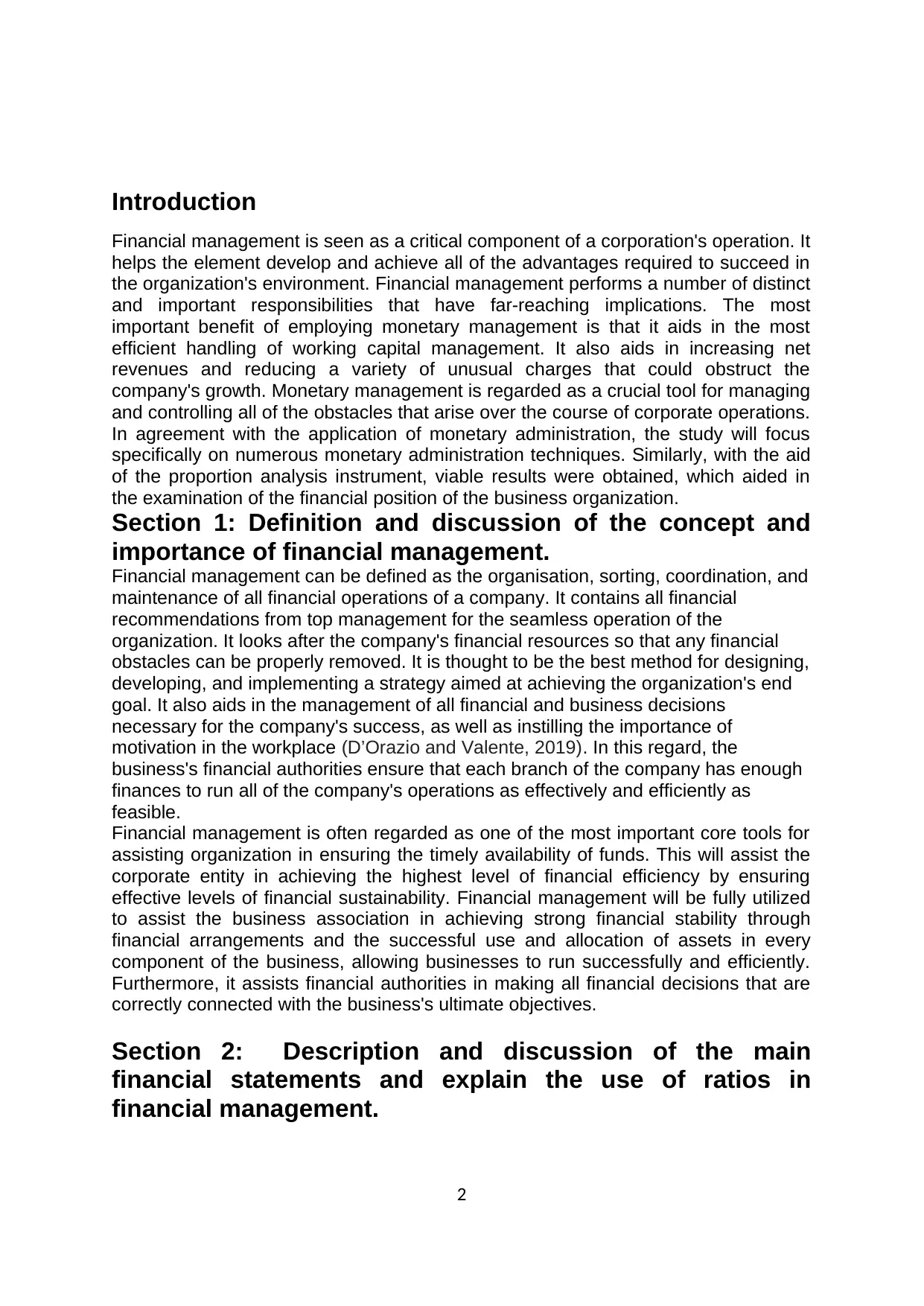
Introduction
Financial management is seen as a critical component of a corporation's operation. It
helps the element develop and achieve all of the advantages required to succeed in
the organization's environment. Financial management performs a number of distinct
and important responsibilities that have far-reaching implications. The most
important benefit of employing monetary management is that it aids in the most
efficient handling of working capital management. It also aids in increasing net
revenues and reducing a variety of unusual charges that could obstruct the
company's growth. Monetary management is regarded as a crucial tool for managing
and controlling all of the obstacles that arise over the course of corporate operations.
In agreement with the application of monetary administration, the study will focus
specifically on numerous monetary administration techniques. Similarly, with the aid
of the proportion analysis instrument, viable results were obtained, which aided in
the examination of the financial position of the business organization.
Section 1: Definition and discussion of the concept and
importance of financial management.
Financial management can be defined as the organisation, sorting, coordination, and
maintenance of all financial operations of a company. It contains all financial
recommendations from top management for the seamless operation of the
organization. It looks after the company's financial resources so that any financial
obstacles can be properly removed. It is thought to be the best method for designing,
developing, and implementing a strategy aimed at achieving the organization's end
goal. It also aids in the management of all financial and business decisions
necessary for the company's success, as well as instilling the importance of
motivation in the workplace (D’Orazio and Valente, 2019). In this regard, the
business's financial authorities ensure that each branch of the company has enough
finances to run all of the company's operations as effectively and efficiently as
feasible.
Financial management is often regarded as one of the most important core tools for
assisting organization in ensuring the timely availability of funds. This will assist the
corporate entity in achieving the highest level of financial efficiency by ensuring
effective levels of financial sustainability. Financial management will be fully utilized
to assist the business association in achieving strong financial stability through
financial arrangements and the successful use and allocation of assets in every
component of the business, allowing businesses to run successfully and efficiently.
Furthermore, it assists financial authorities in making all financial decisions that are
correctly connected with the business's ultimate objectives.
Section 2: Description and discussion of the main
financial statements and explain the use of ratios in
financial management.
2
Financial management is seen as a critical component of a corporation's operation. It
helps the element develop and achieve all of the advantages required to succeed in
the organization's environment. Financial management performs a number of distinct
and important responsibilities that have far-reaching implications. The most
important benefit of employing monetary management is that it aids in the most
efficient handling of working capital management. It also aids in increasing net
revenues and reducing a variety of unusual charges that could obstruct the
company's growth. Monetary management is regarded as a crucial tool for managing
and controlling all of the obstacles that arise over the course of corporate operations.
In agreement with the application of monetary administration, the study will focus
specifically on numerous monetary administration techniques. Similarly, with the aid
of the proportion analysis instrument, viable results were obtained, which aided in
the examination of the financial position of the business organization.
Section 1: Definition and discussion of the concept and
importance of financial management.
Financial management can be defined as the organisation, sorting, coordination, and
maintenance of all financial operations of a company. It contains all financial
recommendations from top management for the seamless operation of the
organization. It looks after the company's financial resources so that any financial
obstacles can be properly removed. It is thought to be the best method for designing,
developing, and implementing a strategy aimed at achieving the organization's end
goal. It also aids in the management of all financial and business decisions
necessary for the company's success, as well as instilling the importance of
motivation in the workplace (D’Orazio and Valente, 2019). In this regard, the
business's financial authorities ensure that each branch of the company has enough
finances to run all of the company's operations as effectively and efficiently as
feasible.
Financial management is often regarded as one of the most important core tools for
assisting organization in ensuring the timely availability of funds. This will assist the
corporate entity in achieving the highest level of financial efficiency by ensuring
effective levels of financial sustainability. Financial management will be fully utilized
to assist the business association in achieving strong financial stability through
financial arrangements and the successful use and allocation of assets in every
component of the business, allowing businesses to run successfully and efficiently.
Furthermore, it assists financial authorities in making all financial decisions that are
correctly connected with the business's ultimate objectives.
Section 2: Description and discussion of the main
financial statements and explain the use of ratios in
financial management.
2
⊘ This is a preview!⊘
Do you want full access?
Subscribe today to unlock all pages.

Trusted by 1+ million students worldwide

The written record containing all transactions linked to the financial operations of the
corporate organization is referred to as financial statements. It aids in the growth of
the company and the establishment of acceptable financial standing in order to
assess the company's success (D’Orazio and Valente, 2019). External authorized
parties such as government officers, tax officers, and auditors, among others,
frequently inspect and evaluate these financial accounts in order to check and
analyses the financial status of the corporate organization. A company organization
prepares numerous types of financial statements, including the balance sheet,
income statement, and cash flow statement, which are listed below:
Balance sheet: It is one of the most main financial statements, with primarily
two components. Assets and liabilities, as well as the shareholder's equity,
are the two components. It aids in the evaluation of business performance,
resulting in the financial condition of the organization for a specific financial
period.
Equation used for preparing a balance sheet: Assets= ( Liabilities + Owner's Fund )
Income statement: It's another crucial financial statement that shows all of
the company's earnings and expenses. It aids in determining if a company's
business operations are profitable or not for a given time period. The income
statement also aids in the representation of a company's financial health.
Equation: Net Income=( Revenue - Expenses )
Cash flow statements: It is a financial statement that aids in the delivery of
accurate information about a company's cash inflows and outflows as a result
of its activities and investment sources (Boyce and Ville, 2017). It also aids in
the assessment of a company's ability to create cash in order to satisfy its
financial commitments quickly and effectively. Finance managers are also
given the authority to make all financial decisions based on the cash flow
statement's outcomes.
Accounting ratios are among the most effective cost management tools for
examining a company's aggregate financial data over two or more years,
primarily to determine its financial status in comparison to its competitors. It is
regarded as one of the most important and necessary instruments used by
businesses to extract and investigate their financial position (D’Orazio and
Valente, 2019). Accounting ratios are also extensively used to evaluate and
contrast the performance of a corporate organization with that of all of its
competitors in intense competition. Accounting ratios are divided into several
categories, including liquidity ratios, profitability ratios, solvency ratios,
turnover ratios, and others, and are used to determine financial performance
in order to accomplish the firm's ultimate goals.
Section 3: Using the template provided:
v. Completing the Information on the ‘Business Review Template
(Ensure that you display your calculations for this detail)
Kindly check the appendix section.
3
corporate organization is referred to as financial statements. It aids in the growth of
the company and the establishment of acceptable financial standing in order to
assess the company's success (D’Orazio and Valente, 2019). External authorized
parties such as government officers, tax officers, and auditors, among others,
frequently inspect and evaluate these financial accounts in order to check and
analyses the financial status of the corporate organization. A company organization
prepares numerous types of financial statements, including the balance sheet,
income statement, and cash flow statement, which are listed below:
Balance sheet: It is one of the most main financial statements, with primarily
two components. Assets and liabilities, as well as the shareholder's equity,
are the two components. It aids in the evaluation of business performance,
resulting in the financial condition of the organization for a specific financial
period.
Equation used for preparing a balance sheet: Assets= ( Liabilities + Owner's Fund )
Income statement: It's another crucial financial statement that shows all of
the company's earnings and expenses. It aids in determining if a company's
business operations are profitable or not for a given time period. The income
statement also aids in the representation of a company's financial health.
Equation: Net Income=( Revenue - Expenses )
Cash flow statements: It is a financial statement that aids in the delivery of
accurate information about a company's cash inflows and outflows as a result
of its activities and investment sources (Boyce and Ville, 2017). It also aids in
the assessment of a company's ability to create cash in order to satisfy its
financial commitments quickly and effectively. Finance managers are also
given the authority to make all financial decisions based on the cash flow
statement's outcomes.
Accounting ratios are among the most effective cost management tools for
examining a company's aggregate financial data over two or more years,
primarily to determine its financial status in comparison to its competitors. It is
regarded as one of the most important and necessary instruments used by
businesses to extract and investigate their financial position (D’Orazio and
Valente, 2019). Accounting ratios are also extensively used to evaluate and
contrast the performance of a corporate organization with that of all of its
competitors in intense competition. Accounting ratios are divided into several
categories, including liquidity ratios, profitability ratios, solvency ratios,
turnover ratios, and others, and are used to determine financial performance
in order to accomplish the firm's ultimate goals.
Section 3: Using the template provided:
v. Completing the Information on the ‘Business Review Template
(Ensure that you display your calculations for this detail)
Kindly check the appendix section.
3
Paraphrase This Document
Need a fresh take? Get an instant paraphrase of this document with our AI Paraphraser
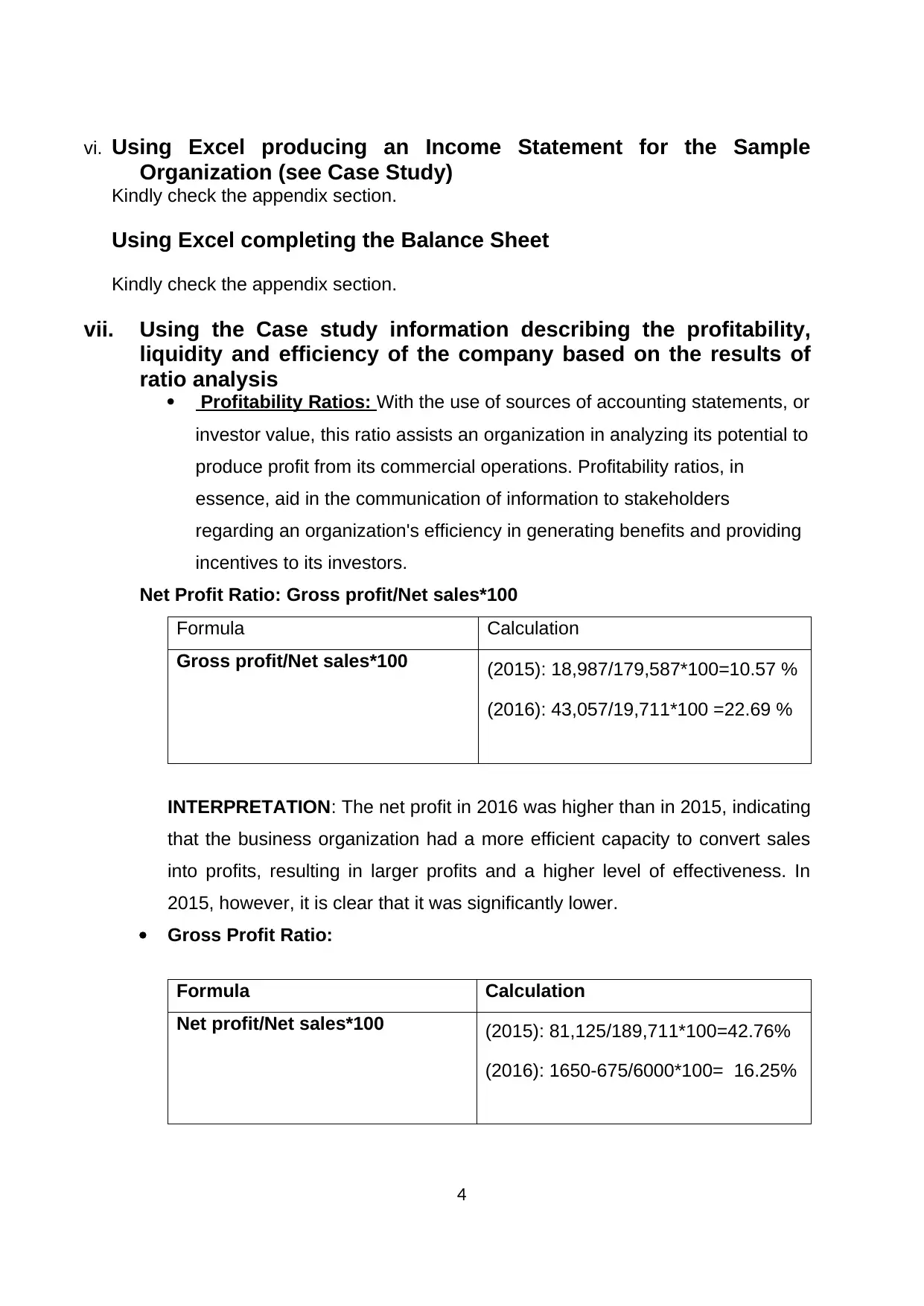
vi. Using Excel producing an Income Statement for the Sample
Organization (see Case Study)
Kindly check the appendix section.
Using Excel completing the Balance Sheet
Kindly check the appendix section.
vii. Using the Case study information describing the profitability,
liquidity and efficiency of the company based on the results of
ratio analysis
Profitability Ratios: With the use of sources of accounting statements, or
investor value, this ratio assists an organization in analyzing its potential to
produce profit from its commercial operations. Profitability ratios, in
essence, aid in the communication of information to stakeholders
regarding an organization's efficiency in generating benefits and providing
incentives to its investors.
Net Profit Ratio: Gross profit/Net sales*100
Formula Calculation
Gross profit/Net sales*100 (2015): 18,987/179,587*100=10.57 %
(2016): 43,057/19,711*100 =22.69 %
INTERPRETATION: The net profit in 2016 was higher than in 2015, indicating
that the business organization had a more efficient capacity to convert sales
into profits, resulting in larger profits and a higher level of effectiveness. In
2015, however, it is clear that it was significantly lower.
Gross Profit Ratio:
Formula Calculation
Net profit/Net sales*100 (2015): 81,125/189,711*100=42.76%
(2016): 1650-675/6000*100= 16.25%
4
Organization (see Case Study)
Kindly check the appendix section.
Using Excel completing the Balance Sheet
Kindly check the appendix section.
vii. Using the Case study information describing the profitability,
liquidity and efficiency of the company based on the results of
ratio analysis
Profitability Ratios: With the use of sources of accounting statements, or
investor value, this ratio assists an organization in analyzing its potential to
produce profit from its commercial operations. Profitability ratios, in
essence, aid in the communication of information to stakeholders
regarding an organization's efficiency in generating benefits and providing
incentives to its investors.
Net Profit Ratio: Gross profit/Net sales*100
Formula Calculation
Gross profit/Net sales*100 (2015): 18,987/179,587*100=10.57 %
(2016): 43,057/19,711*100 =22.69 %
INTERPRETATION: The net profit in 2016 was higher than in 2015, indicating
that the business organization had a more efficient capacity to convert sales
into profits, resulting in larger profits and a higher level of effectiveness. In
2015, however, it is clear that it was significantly lower.
Gross Profit Ratio:
Formula Calculation
Net profit/Net sales*100 (2015): 81,125/189,711*100=42.76%
(2016): 1650-675/6000*100= 16.25%
4
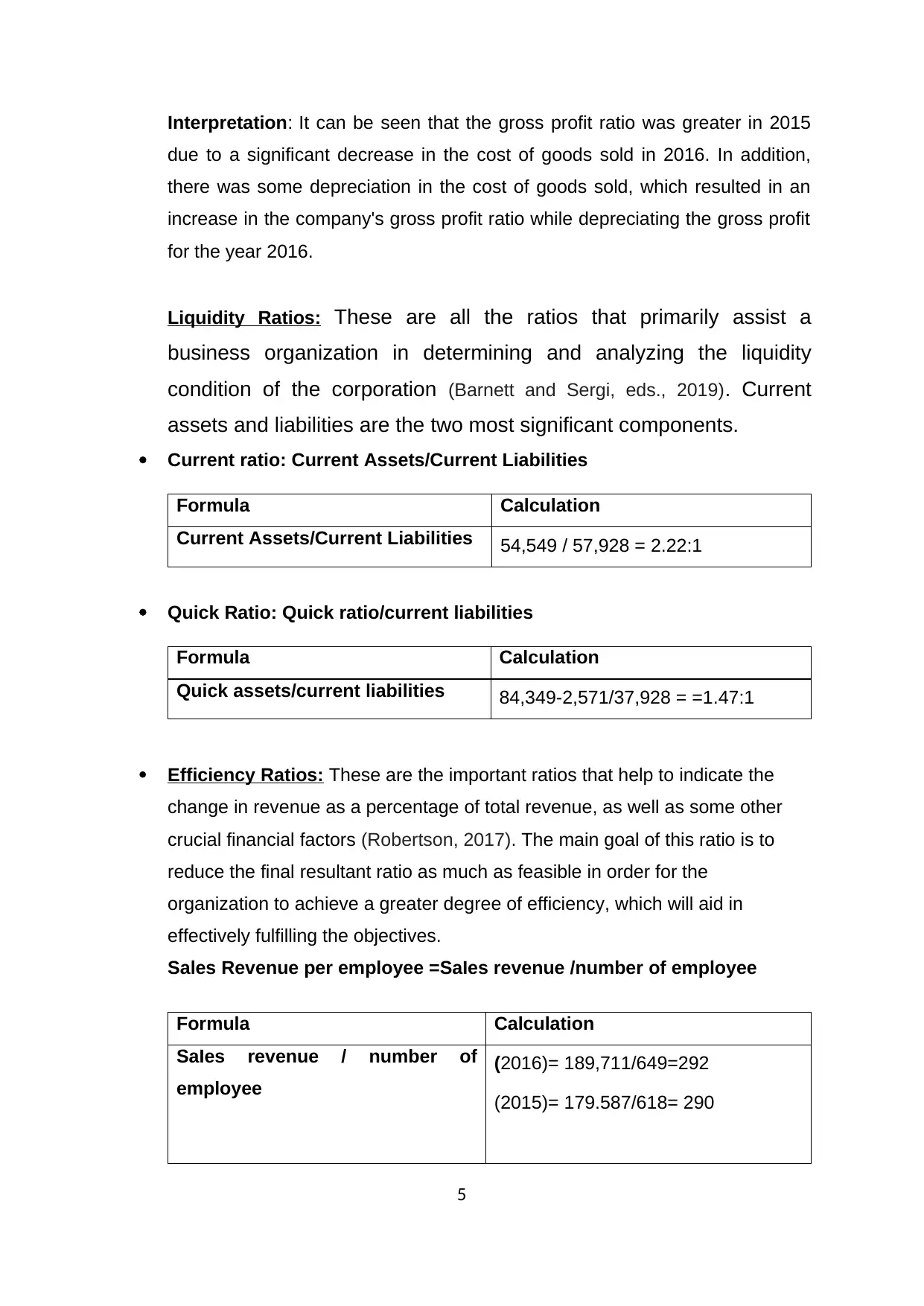
Interpretation: It can be seen that the gross profit ratio was greater in 2015
due to a significant decrease in the cost of goods sold in 2016. In addition,
there was some depreciation in the cost of goods sold, which resulted in an
increase in the company's gross profit ratio while depreciating the gross profit
for the year 2016.
Liquidity Ratios: These are all the ratios that primarily assist a
business organization in determining and analyzing the liquidity
condition of the corporation (Barnett and Sergi, eds., 2019). Current
assets and liabilities are the two most significant components.
Current ratio: Current Assets/Current Liabilities
Formula Calculation
Current Assets/Current Liabilities 54,549 / 57,928 = 2.22:1
Quick Ratio: Quick ratio/current liabilities
Formula Calculation
Quick assets/current liabilities 84,349-2,571/37,928 = =1.47:1
Efficiency Ratios: These are the important ratios that help to indicate the
change in revenue as a percentage of total revenue, as well as some other
crucial financial factors (Robertson, 2017). The main goal of this ratio is to
reduce the final resultant ratio as much as feasible in order for the
organization to achieve a greater degree of efficiency, which will aid in
effectively fulfilling the objectives.
Sales Revenue per employee =SaIes revenue /number of employee
Formula Calculation
SaIes revenue / number of
employee
(2016)= 189,711/649=292
(2015)= 179.587/618= 290
5
due to a significant decrease in the cost of goods sold in 2016. In addition,
there was some depreciation in the cost of goods sold, which resulted in an
increase in the company's gross profit ratio while depreciating the gross profit
for the year 2016.
Liquidity Ratios: These are all the ratios that primarily assist a
business organization in determining and analyzing the liquidity
condition of the corporation (Barnett and Sergi, eds., 2019). Current
assets and liabilities are the two most significant components.
Current ratio: Current Assets/Current Liabilities
Formula Calculation
Current Assets/Current Liabilities 54,549 / 57,928 = 2.22:1
Quick Ratio: Quick ratio/current liabilities
Formula Calculation
Quick assets/current liabilities 84,349-2,571/37,928 = =1.47:1
Efficiency Ratios: These are the important ratios that help to indicate the
change in revenue as a percentage of total revenue, as well as some other
crucial financial factors (Robertson, 2017). The main goal of this ratio is to
reduce the final resultant ratio as much as feasible in order for the
organization to achieve a greater degree of efficiency, which will aid in
effectively fulfilling the objectives.
Sales Revenue per employee =SaIes revenue /number of employee
Formula Calculation
SaIes revenue / number of
employee
(2016)= 189,711/649=292
(2015)= 179.587/618= 290
5
⊘ This is a preview!⊘
Do you want full access?
Subscribe today to unlock all pages.

Trusted by 1+ million students worldwide
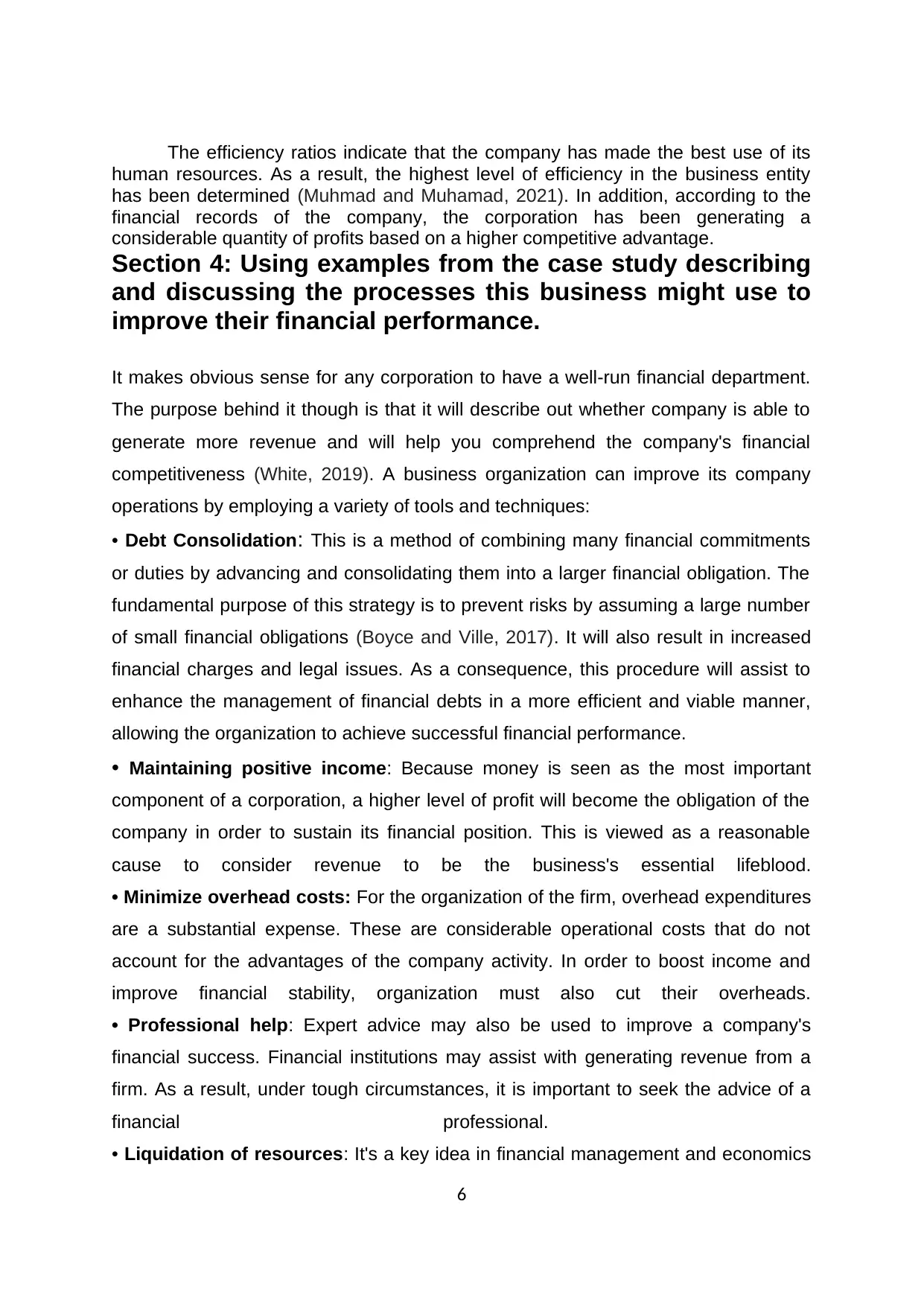
The efficiency ratios indicate that the company has made the best use of its
human resources. As a result, the highest level of efficiency in the business entity
has been determined (Muhmad and Muhamad, 2021). In addition, according to the
financial records of the company, the corporation has been generating a
considerable quantity of profits based on a higher competitive advantage.
Section 4: Using examples from the case study describing
and discussing the processes this business might use to
improve their financial performance.
It makes obvious sense for any corporation to have a well-run financial department.
The purpose behind it though is that it will describe out whether company is able to
generate more revenue and will help you comprehend the company's financial
competitiveness (White, 2019). A business organization can improve its company
operations by employing a variety of tools and techniques:
• Debt Consolidation: This is a method of combining many financial commitments
or duties by advancing and consolidating them into a larger financial obligation. The
fundamental purpose of this strategy is to prevent risks by assuming a large number
of small financial obligations (Boyce and Ville, 2017). It will also result in increased
financial charges and legal issues. As a consequence, this procedure will assist to
enhance the management of financial debts in a more efficient and viable manner,
allowing the organization to achieve successful financial performance.
• Maintaining positive income: Because money is seen as the most important
component of a corporation, a higher level of profit will become the obligation of the
company in order to sustain its financial position. This is viewed as a reasonable
cause to consider revenue to be the business's essential lifeblood.
• Minimize overhead costs: For the organization of the firm, overhead expenditures
are a substantial expense. These are considerable operational costs that do not
account for the advantages of the company activity. In order to boost income and
improve financial stability, organization must also cut their overheads.
• Professional help: Expert advice may also be used to improve a company's
financial success. Financial institutions may assist with generating revenue from a
firm. As a result, under tough circumstances, it is important to seek the advice of a
financial professional.
• Liquidation of resources: It's a key idea in financial management and economics
6
human resources. As a result, the highest level of efficiency in the business entity
has been determined (Muhmad and Muhamad, 2021). In addition, according to the
financial records of the company, the corporation has been generating a
considerable quantity of profits based on a higher competitive advantage.
Section 4: Using examples from the case study describing
and discussing the processes this business might use to
improve their financial performance.
It makes obvious sense for any corporation to have a well-run financial department.
The purpose behind it though is that it will describe out whether company is able to
generate more revenue and will help you comprehend the company's financial
competitiveness (White, 2019). A business organization can improve its company
operations by employing a variety of tools and techniques:
• Debt Consolidation: This is a method of combining many financial commitments
or duties by advancing and consolidating them into a larger financial obligation. The
fundamental purpose of this strategy is to prevent risks by assuming a large number
of small financial obligations (Boyce and Ville, 2017). It will also result in increased
financial charges and legal issues. As a consequence, this procedure will assist to
enhance the management of financial debts in a more efficient and viable manner,
allowing the organization to achieve successful financial performance.
• Maintaining positive income: Because money is seen as the most important
component of a corporation, a higher level of profit will become the obligation of the
company in order to sustain its financial position. This is viewed as a reasonable
cause to consider revenue to be the business's essential lifeblood.
• Minimize overhead costs: For the organization of the firm, overhead expenditures
are a substantial expense. These are considerable operational costs that do not
account for the advantages of the company activity. In order to boost income and
improve financial stability, organization must also cut their overheads.
• Professional help: Expert advice may also be used to improve a company's
financial success. Financial institutions may assist with generating revenue from a
firm. As a result, under tough circumstances, it is important to seek the advice of a
financial professional.
• Liquidation of resources: It's a key idea in financial management and economics
6
Paraphrase This Document
Need a fresh take? Get an instant paraphrase of this document with our AI Paraphraser

that tries to get a company to the point when its assets or resources are sold (Gong
and Kim, 2018). As a result, the business's common components, namely assets,
might be regarded liquidation targets.
Conclusion
From the foregoing research, it can be inferred that it is quite important for any
corporate organization. It must be used to apply financial management to all parts of
a corporate organization. Furthermore, the financial statement and its full
comprehension must be completed in such a way that the company may operate
effectively and attain the best level of productivity possible. This will aid the company
organization in obtaining more and more benefits in line with a high degree of
achievement in the long term in order to achieve success.
7
and Kim, 2018). As a result, the business's common components, namely assets,
might be regarded liquidation targets.
Conclusion
From the foregoing research, it can be inferred that it is quite important for any
corporate organization. It must be used to apply financial management to all parts of
a corporate organization. Furthermore, the financial statement and its full
comprehension must be completed in such a way that the company may operate
effectively and attain the best level of productivity possible. This will aid the company
organization in obtaining more and more benefits in line with a high degree of
achievement in the long term in order to achieve success.
7

References
D’Orazio, P. and Valente, M., 2019. The role of finance in environmental innovation
diffusion: An evolutionary modeling approach. Journal of Economic Behavior
& Organization, 162. pp.417-439.
Barnett, W. A. and Sergi, B. S. eds., 2019. Asia-Pacific contemporary finance and
development. Emerald Group Publishing.
Robertson, J., 2017. Emergent new finance: hedge funds and private equity funds in
East Asia. Journal of the Asia Pacific Economy, 22(4). pp.626-646.
Muhmad, S. N. and Muhamad, R., 2021. Sustainable business practices and
financial performance during pre-and post-SDG adoption periods: a
systematic review. Journal of Sustainable Finance & Investment, 11(4).
pp.291-309.
White, J. B., 2019. Using the Mega Millions Lottery in Your Principles of Finance
Class. Business Education Innovation Journal, 11(1).
Gong, C. and Kim, S., 2018. Regional business cycle synchronization in emerging
and developing countries: Regional or global integration? Trade or financial
integration?. Journal of International Money and Finance, 84. pp.42-57.
Boyce, G. and Ville, S., 2017. The development of modern business. Macmillan
International Higher Education.
Khaki, A. R., 2017. Does access to finance alleviate poverty? A case study of SGSY
beneficiaries in Kashmir Valley. International Journal of Social Economics.
Hatfield, P. and Kruse, T.A., 2019. An examination of gender diversity and editorial
boards in finance. Journal of Accounting and Finance, 19(8). pp.132-142.
Shane, S. and Nicolaou, N., 2018. Exploring the changing institutions of early-stage
finance. Journal of Institutional Economics, 14(6). pp.1121-1137.
8
D’Orazio, P. and Valente, M., 2019. The role of finance in environmental innovation
diffusion: An evolutionary modeling approach. Journal of Economic Behavior
& Organization, 162. pp.417-439.
Barnett, W. A. and Sergi, B. S. eds., 2019. Asia-Pacific contemporary finance and
development. Emerald Group Publishing.
Robertson, J., 2017. Emergent new finance: hedge funds and private equity funds in
East Asia. Journal of the Asia Pacific Economy, 22(4). pp.626-646.
Muhmad, S. N. and Muhamad, R., 2021. Sustainable business practices and
financial performance during pre-and post-SDG adoption periods: a
systematic review. Journal of Sustainable Finance & Investment, 11(4).
pp.291-309.
White, J. B., 2019. Using the Mega Millions Lottery in Your Principles of Finance
Class. Business Education Innovation Journal, 11(1).
Gong, C. and Kim, S., 2018. Regional business cycle synchronization in emerging
and developing countries: Regional or global integration? Trade or financial
integration?. Journal of International Money and Finance, 84. pp.42-57.
Boyce, G. and Ville, S., 2017. The development of modern business. Macmillan
International Higher Education.
Khaki, A. R., 2017. Does access to finance alleviate poverty? A case study of SGSY
beneficiaries in Kashmir Valley. International Journal of Social Economics.
Hatfield, P. and Kruse, T.A., 2019. An examination of gender diversity and editorial
boards in finance. Journal of Accounting and Finance, 19(8). pp.132-142.
Shane, S. and Nicolaou, N., 2018. Exploring the changing institutions of early-stage
finance. Journal of Institutional Economics, 14(6). pp.1121-1137.
8
⊘ This is a preview!⊘
Do you want full access?
Subscribe today to unlock all pages.

Trusted by 1+ million students worldwide

Appendix:
(1) Income Statement
(2) Balance Sheet
9
(1) Income Statement
(2) Balance Sheet
9
Paraphrase This Document
Need a fresh take? Get an instant paraphrase of this document with our AI Paraphraser

(3) Business Review Template
10
10
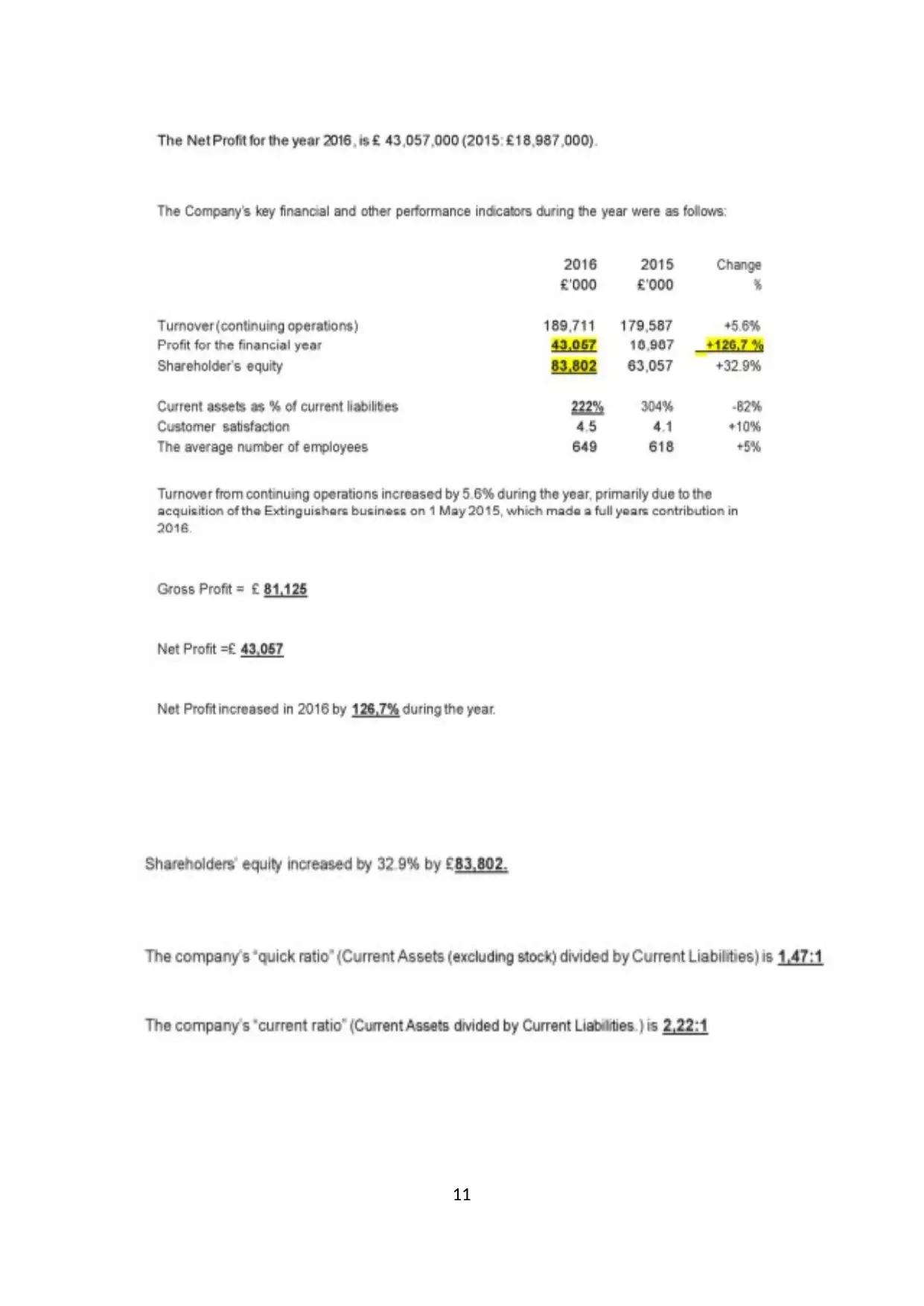
11
⊘ This is a preview!⊘
Do you want full access?
Subscribe today to unlock all pages.

Trusted by 1+ million students worldwide
1 out of 13
Related Documents
Your All-in-One AI-Powered Toolkit for Academic Success.
+13062052269
info@desklib.com
Available 24*7 on WhatsApp / Email
![[object Object]](/_next/static/media/star-bottom.7253800d.svg)
Unlock your academic potential
Copyright © 2020–2026 A2Z Services. All Rights Reserved. Developed and managed by ZUCOL.
